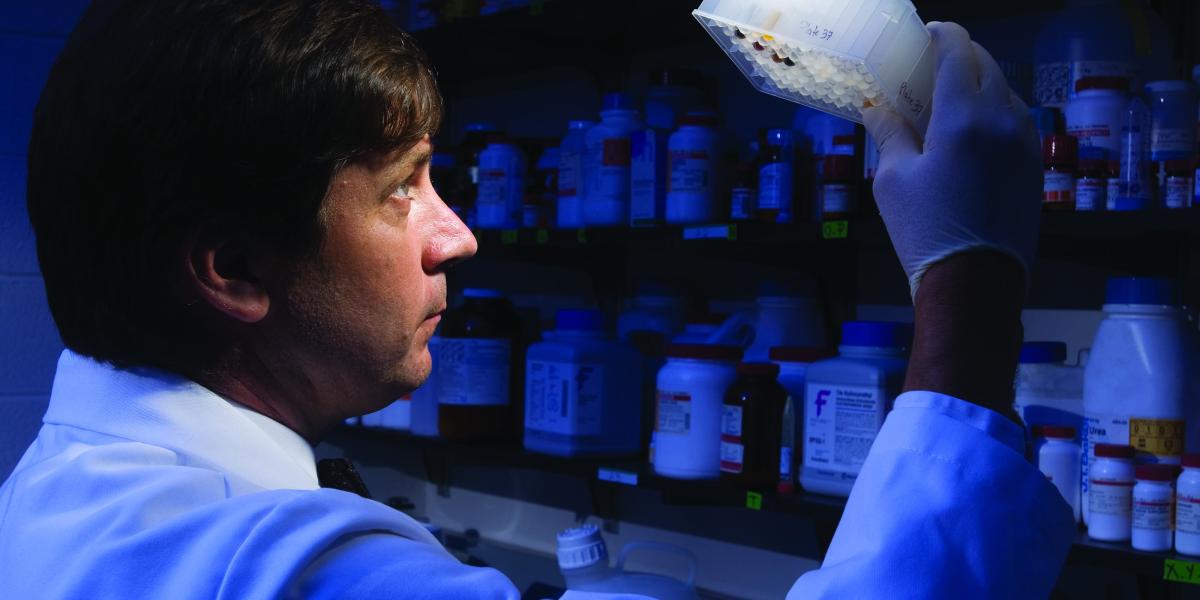Teaching Old Drugs New Tricks
David Sullivan's solution for speeding up drug development: Screen existing approved drugs for new uses.
Bringing a new drug to market takes, on average, 15 years and $800 million—which probably explains why just 20 to 30 new compounds are approved each year by the FDA. "At this rate it will take more than 300 years for the number of drugs in the world to double," note the Bloomberg School's David Sullivan, MD, and medical student Curtis Chong, in the August 9 issue of Naturemagazine.
The current time- and money-consuming strategy for drug discovery is "ill-equipped" to combat newly emerging diseases (think avian flu), drug-resistant pathogens, or diseases afflicting poor countries that have a small financial market, the researchers note in their Nature editorial.
Their proposed solution? Dramatically beef up efforts to screen existing drugs for new uses.
Currently, the most comprehensive library of approved drugs available for screening is the Johns Hopkins Clinical Compound Library (JHCCL), a catalog of active ingredients of compounds found in 2,687 drugs.
Sullivan and Chong want to see that library expand to include the approximately 9,990 drugs known to clinical medicine. And they've challenged the scientific community to use it to screen every neglected disease by 2011.
Sullivan, an associate professor of Molecular Microbiology and Immunology, is a believer in the approach because he's seen it work firsthand.
In 2006, he and his colleagues used the JHCCL to screen the allergy medication astemizole for new uses and found it to be a potential treatment for malaria. The study, largely funded by the Johns Hopkins Malaria Research Institute, determined that in a test tube the antihistamine killed the Plasmodium parasite, which causes malaria in humans. As an added bonus, the former allergy medication stood up to parasite strains that were resistant to chloroquine, a traditional malaria therapy. Astemizole has been shown effective in mouse models, and validation studies in human malaria trials are currently pending.
Currently, say Sullivan and Chong, there are at least 17 existing drugs in various stages of clinical and animal testing for new uses.
Currently, there are at least 17 existing drugs in various stages of clinical and animal testing for new uses, according to David Sullivan and Curtis Chang.
Because most existing drugs have already been approved for human use by the FDA or some other regulatory agency, researchers can bypass the early part of the drug approval process (phase I toxicological and pharmokinetic assessments), which accounts for nearly 40 percent of the overall cost of drug development.
Beyond cost savings, the screening strategy holds particular promise for bringing new therapies more safely to the developing world, the researchers note. Follow-up safety evaluations of a new drug after it has been widely marketed (known as phase IV clinical trials) cost about $100 million per drug—which puts the practice out of reach for cash-strapped countries. "Because many existing drugs have undergone phase IV surveillance in millions of patients, the same stringent safety standards required by users in developed countries can be offered to patients [in poorer nations]," Sullivan notes.
Building on existing libraries of available drugs to reach the 9,990-mark will require the donation and purchase of some drugs, and the organic synthesis of others. The only rule for using the library proposed by Sullivan and Chong, they say, would be an agreement to share the new data and "redeposit" results, including pharmacokinetics and clinical properties of the drugs, into a comprehensive public database.
The success of the undertaking will rely heavily on cooperation between academic institutions, the pharmaceutical industry and the National Institutes of Health (NIH) through a collaboration of intellectual, physical and financial resources, Sullivan says.
He acknowledges the ambitious scope of the project, yet remains optimistic. "We're almost there," he says. "It just takes time, money, effort and people to put it together. It's an economy of scale and it needs to be scaled up."
